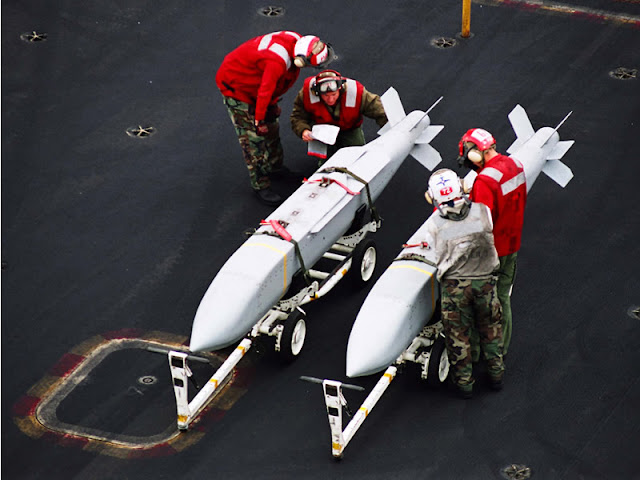US weapons: JSOW Is Upgraded For War Against China
May 1, 2013: The U.S. Navy has successfully tested the powered (ER for extended range) version of the AGM-154 JSOW (Joint Stand Off Weapon) glide bomb.

The AGM-154 JSOW is a long range GPS guided glide bomb. The F-35 can accommodate two AGM-154 bombs internally in addition to two air to air missiles. In a mission to disable enemy air defenses, some F-35's would carry the JSOW while others would provide escort with a full load of air to air missiles.
Earlier problems with the fuel system were fixed and this enabled the small jet engine to propel a JSOW nearly 500 kilometers. Normally, JSOW is unpowered but able to glide for up to 22-130 kilometers (depending on the altitude it is dropped from).
The powered version (JSOW-ER) has been in development for six years and has been delayed by technical problems and a shortage of customers.
JSOW entered service in the late 1990s, and Australia, Canada, Greece, Finland, Poland, Singapore, Turkey, and the Netherlands have bought small quantities. The U.S. Navy and Air Force have bought over a thousand and used 400 in the Balkans, Iraq, and Afghanistan.
The JSOW is becoming a popular, if specialized, smart bomb, even though it has had little use in combat. JSOW is basically a smart bomb with wings. That enables it to glide up to 130 kilometers from the aircraft dropping it. Range is about 22 kilometers if dropped from low altitude. JSOW also contains more elaborate fins and software that enables it to follow a specific route. Like the wingless JDAM smart bomb, JSOW uses GPS and inertial guidance (as a backup) to find its target. Like JDAM, JSOW will hit within 10 meters (31 feet) of its aiming point. JSOW can also attack moving ships.
There are three versions of JSOW. AGM-154A carries 145 bomblets that attack personnel and vehicles. AGM-154B contains six SADARM bomblets that seek out and destroy armored vehicles in an area 300 by 600 meters. This one costs $490,000 each. The AGM-154C carries a 361 kg (794 pound) warhead that can penetrate concrete or earth before detonating the high explosives it carries. This model contains a video link that allows for hitting very small targets (like going through a window). The C1 version is able to hit moving targets.
Each JSOW weighs 500-618 kg (1,100-1,500 pounds), depending on type. Not a lot of JSOWs have been bought because there is not a lot of demand for them. The purpose of a standoff weapon is to keep the aircraft away from enemy anti-aircraft defenses (mainly missiles). Some JSOW have been used in Iraq (between 1999 and 2003) and Afghanistan (2001). But in most cases, the much cheaper JDAM (about $26,000 each) does the job just as well. But against a better equipped foe, like China, Syria, Iran, or North Korea, JSOW would be more useful, and that’s why JSOW remains in production and development continued on JSOW ER.
Strategy Page

The AGM-154 JSOW is a long range GPS guided glide bomb. The F-35 can accommodate two AGM-154 bombs internally in addition to two air to air missiles. In a mission to disable enemy air defenses, some F-35's would carry the JSOW while others would provide escort with a full load of air to air missiles.
Earlier problems with the fuel system were fixed and this enabled the small jet engine to propel a JSOW nearly 500 kilometers. Normally, JSOW is unpowered but able to glide for up to 22-130 kilometers (depending on the altitude it is dropped from).
The powered version (JSOW-ER) has been in development for six years and has been delayed by technical problems and a shortage of customers.
JSOW entered service in the late 1990s, and Australia, Canada, Greece, Finland, Poland, Singapore, Turkey, and the Netherlands have bought small quantities. The U.S. Navy and Air Force have bought over a thousand and used 400 in the Balkans, Iraq, and Afghanistan.
The JSOW is becoming a popular, if specialized, smart bomb, even though it has had little use in combat. JSOW is basically a smart bomb with wings. That enables it to glide up to 130 kilometers from the aircraft dropping it. Range is about 22 kilometers if dropped from low altitude. JSOW also contains more elaborate fins and software that enables it to follow a specific route. Like the wingless JDAM smart bomb, JSOW uses GPS and inertial guidance (as a backup) to find its target. Like JDAM, JSOW will hit within 10 meters (31 feet) of its aiming point. JSOW can also attack moving ships.
There are three versions of JSOW. AGM-154A carries 145 bomblets that attack personnel and vehicles. AGM-154B contains six SADARM bomblets that seek out and destroy armored vehicles in an area 300 by 600 meters. This one costs $490,000 each. The AGM-154C carries a 361 kg (794 pound) warhead that can penetrate concrete or earth before detonating the high explosives it carries. This model contains a video link that allows for hitting very small targets (like going through a window). The C1 version is able to hit moving targets.
Each JSOW weighs 500-618 kg (1,100-1,500 pounds), depending on type. Not a lot of JSOWs have been bought because there is not a lot of demand for them. The purpose of a standoff weapon is to keep the aircraft away from enemy anti-aircraft defenses (mainly missiles). Some JSOW have been used in Iraq (between 1999 and 2003) and Afghanistan (2001). But in most cases, the much cheaper JDAM (about $26,000 each) does the job just as well. But against a better equipped foe, like China, Syria, Iran, or North Korea, JSOW would be more useful, and that’s why JSOW remains in production and development continued on JSOW ER.
Strategy Page
louis vuitton
ReplyDeleteuggs outlet
tiffany jewellery
bottega veneta outlet
polo ralph lauren
beats headphones
ugg boots uk
louis vuitton handbags
chaussure louboutin
ugg outlet
20161125lck